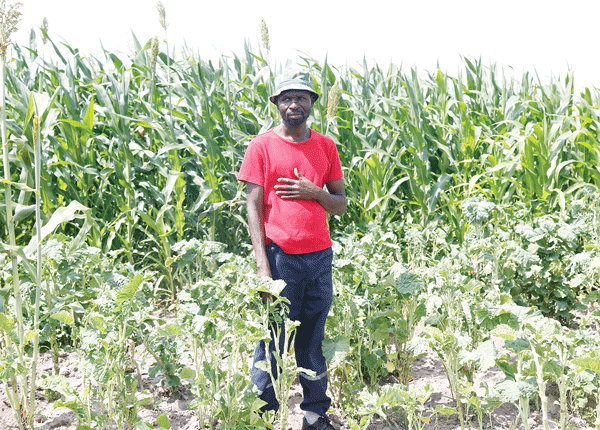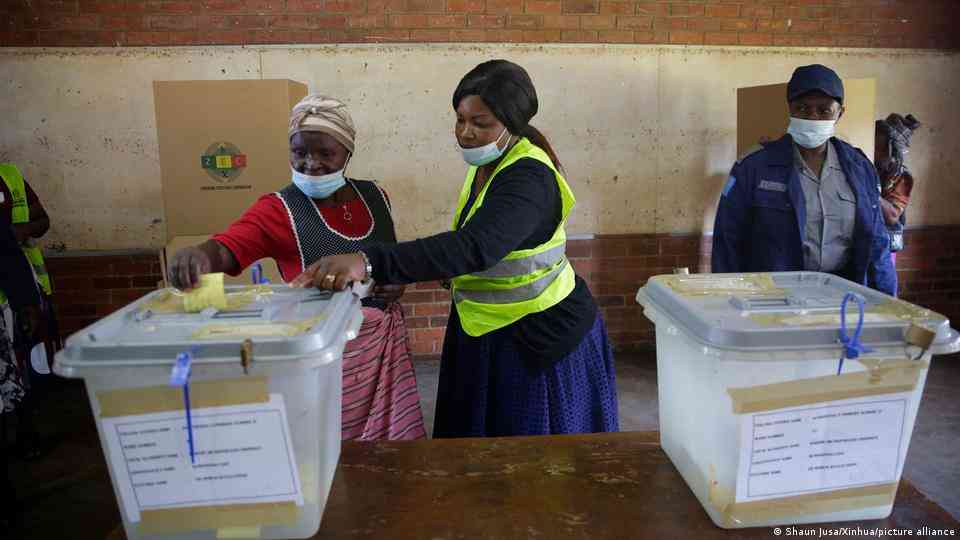
BY LEARNMORE NYONI For Misheck Chikono, a communal farmer based in Ziboni under Chief Masunda in Zvishavane, Midlands province, rainfall patterns seem to have changed.
“In the past, agricultural extension officers urged us to start dry planting of maize seed by October 15 every agricultural season, so that our seed receives the first rains.
“Things have not been the same. We are no longer receiving our first rains by October 15. In the last 10 or so years, we received our first meaningful rains in the early weeks of December,” he says.

Oblivious of the scientific phenomenon known as climate change, many communal farmers like Chikono have learnt through trial and error over years of poor harvests and droughts that rainfall patterns and temperatures have changed.
Climate change has seen a drop in rainfall and rise in temperatures that the recent re-classification of the Zimbabwe agro-ecological zones saw Zvishavane dropping from region 5 to region 5A, which receives between 300-600mm annual rainfall, which is not enough for long-season maize crop varieties.
Zvishavane community, like most communal farmers in the country, depend on rainfed agriculture.
Political instability, economic recession and more recently, the COVID-19-induced economic shocks, have further worsened Zimbabwe’s rural communities’ susceptibility to climate shocks.
As at April 1, 2021, an average Zimbabwean rural household had 26,6kg cereal stocks, a dire situation that requires urgent intervention to break the cycle of vulnerability.
- Chamisa under fire over US$120K donation
- Mavhunga puts DeMbare into Chibuku quarterfinals
- Pension funds bet on Cabora Bassa oilfields
- Councils defy govt fire tender directive
Keep Reading
Effects of climate change are not only felt in rural communities, the world is getting warmer and humans are to blame.

The increased use of fossil fuels like gas, coal and oils for both domestic and industrial purposes have led to the increased release of gases, especially carbon dioxide into the atmosphere.
Carbon dioxide traps the heat from the sun, making the earth warmer.
Statistics show that average world temperatures have risen by 1,2% since the pre-industrial era and this has led to extreme weather patterns that have caused droughts, floods, cyclones and pest attacks across Africa.
While no society is immune to the effects of climate change, Africa’s populations are the most vulnerable to the harshest climate change effects due to lack of resources to set up necessary climate adaptation responses.
Granted, Africa contributes less than 4% to global warming.
Climate change is making Africa’s problems such as deep rural poverty, environmental degradation, malnutrition, food insecurity and exposure to external shocks such as COVID-19 become more pronounced than ever.
Zimbabwe’s poor rural communities are the most vulnerable to climate change, with very little or no resources to cushion or at least respond to climate shocks like floods, droughts, pest attacks and depletion of water resources.

A 2021 World Bank report estimated that 6,1 million people in Zimbabwe lived below the international poverty line, a glaring structural economic vulnerability of the population to climate and other external shocks like COVID-19.
Zimbabwe’s socio-economic problems compound the vulnerabilities of rural communities and has forced a lot of girls out of school, which has seen many of them marrying as an easy way out of poverty.
According to the Zimbabwe National Statistics Agency, one in every three girls marries before reaching the age of 18.
For instance, when Cyclone Idai, a tropical cyclone characterised by floods and landslides, hit Manicaland, Masvingo and Midlands provinces in March 2019, it rendered over 17 000 families homeless and more than 300 people dead, with hundreds still missing to date.
Communities in the Chimanimani and Chipinge districts were the hardest hit and humanitarian organisations had to respond, building temporary structures and providing the much-needed food, water, health and sanitation facilities.
While the communities in the eastern part of Zimbabwe were still counting their Cyclone Idai disaster losses, another cyclone named Ana, characterised by heavy rains and strong winds, tore across Madagascar, Mozambique, Malawi and Zimbabwe, leaving 80 people dead in January 2022.
The cyclone led to destruction of infrastructure, thereby destroying livelihoods and food security.
Zimbabwe, like many countries in the southern African region, has faced destructive floods and storms that continue to devastate communities at an increasing frequency, magnitude and severity emanating from climate change effects.
Crop pest attacks have also affected the region.
Agricultural experts argue that the long dry spells after the rainy season commences are the cause of the outbreak of the fall armyworm — a pest that is causing cereal crop losses, especially maize.
This seasonal variation in rainfall distribution is attributable to climate change.
Maize is the staple in most parts of southern Africa.
Climate change expert and activist Priyanka Naik says there is need for a huge investment in climate adaptation and resilience for vulnerable rural communities to be insulated against the debilitating effects of climate change.
“If you want to reduce your vulnerability, it requires a lot of finance. Rural communities would need funding for big projects to increase resilience and reduce their vulnerability. But also, on the grassroots level there are a lot of things that can happen, Zimbabwe can do green gardens, reduce deforestation which is increasing due to illegal mining activities, plant trees and develop small water harvesting systems because our drier months are going to be longer,” she said.
With funding from the British High Commission, Naik and her two partners from Uganda and Zambia started small climate change adaptation projects across the three countries, planting trees and offering climate education to young children in school, women and old people on why climatic conditions have changed and helping them appreciate what they can do to adapt to the changes.
Granted, climate change has also led to another covert problem. Since rural diets in Zimbabwe mainly consist of what families produce, the diets are largely starchy, leading to child malnutrition.
One in every five children under the age of five has vitamin A deficiency.
As such, there is need for Africa’s rural communities to change as the weather changes, lest the effects of global warming continue to increase to catastrophic levels.
More urgent climate actions are needed to promote climate adaptation and resilience.
Otherwise, Africa’s most vulnerable rural populations will continue to lose crops, animal and human life to the effects of climate change.
Intergovernmental Panel on Climate Change defines climate adaptation as an “adjustment in natural or human systems in response to actual or expected climatic stimuli or their effects” which may harm communities.
Training local communities on what climate change is, how it is impacting their lives and what they can do to promote environmental sustainability is central to preserving lives and livelihoods as well as promoting environmental awareness and resilience.
In 2021, Environment, Climate, Tourism and Hospitality Industry minister Nqobizitha Mangaliso Ndhlovu launched the National Climate Change Learning Strategy to promote climate change literacy at both the local and national levels so that young generations can respond better to future climate change conditions.
Zimbabwe has already started implementing this strategy through climate change awareness roadshows in rural communities, training of climate change journalists as well as participating at various regional and international climate learning events.
However, more needs to be done on the ground to increase both awareness and responsive action against potential and current effects of climate change on both the environment and livelihoods.
Zimbabwe also has a national climate policy that aims at promoting climate resilience and a low carbon development policy.
This policy is supported by the national climate response strategy, the low carbon development strategy, the national adaptation plan, national environmental policy and the renewable energy policy among other bold and high-sounding policies.
While these policy and national strategy documents are commendable structural interventions, their value may be marginal if rural and vulnerable communities like those in the eastern part of Zimbabwe continue to suffer at the hands of every storm, cyclone and flood that comes their way.
The 2021 Zimbabwe Vulnerability Assessment Committee (ZimVAC) report shows that cash shortages, crop pests and cereal price changes were the most prevalent shocks experienced by rural communities in Zimbabwe.
Climate smart agriculture, known as Pfumvudza, is a government-driven crop production intensification programme that promotes efficient use of resources where farmers work on 16m x39m agricultural plots.
An average communal farmer can easily prepare, tend and even water this small plot in the event of dry spells.
In promoting uptake of the Pfumvudza programme, government is encouraging all the 1,8 million beneficiaries of its free presidential inputs scheme to establish three Pfumvudza plots.
Communal farmers in ward 9 under Chief Gwesela in Zhombe commended the Pfumvudza concept, which they said has also encouraged the youth in their community to take up agriculture.
“Initially, we had reservations about this ‘dhiga ufe’ (loosely translated dig and die) concept. When we were told that a 16mx39m plot can feed a family of six for a year, we took it along and we are beginning to see the positive results,” says a Zhombe village head, Khetha Manzini.
The objective of the programme is to climate-proof communal farmers who constitute 80% of farmers in the country.
The 2021 ZimVAC reported a 66% uptake of Pfumvudza in Mashonaland Central province.
Owing to good rains, agriculture climate-proofing and other support interventions by government and other development partners, Zimbabwe produced a record 2,7 million tonnes of the staple maize crop, which was triple the yield of the previous year.
Regenerative agriculture, which simply means going back to the indigenous circular agricultural systems, is one of the proven panaceas to the climate challenges bedevilling Africa.
Further, local communities can take active remedial action to counter the effects of climate change in their localities and not just wait for government interventions.
An arid community in the Gudo area under Chief Mazvihwa in rural Zvishavane dug out dead level contours to harvest rainwater as a climate-proofing strategy to counter erratic rainfall patterns.
According to Emmanuel Mhike, a community development practitioner based in Mazvihwa, the community captures runoff water and channels it into rainwater harvesting ponds that hold up to 200 000 litres, solving not only the climate challenges, but also creating a livelihood option.
Muonde Trust, a research and community development organisation based in Mazvihwa, Zimbabwe, has been capacitating locals in arid rural Zvishavane with water harvesting skills and other climate-proofing strategies.
“In 1916, a man called Mutupo started drain away contours in our community. People were forced to do these contours to reduce clogging of water in fields because then, there were lots of rains.
“However, over the years, the amount of rains we were receiving started to drop significantly and people were failing to harvest well. I then did some research and then started dead level contours, which store water in fields instead of draining the rainwater away,” said Muonde Trust director and lead researcher Abraham Ndlovu.
Ndlovu has been training a lot of people in his community to do these dead level contours which, according to him, “store, spread and sink” rainwater in fields and his trainees have started to enjoy the benefits.
Handsome Pfundu, one of Muonde Trust dead level contours water harvesting trainees, is enjoying the benefits of adopting this change.
“I plant anything that I want when I want because I have water all year round that I capture during the rainy season. I make a living from tomatoes, water melons, onions, wheat and other horticultural crops, which I sell in Zvishavane town,” Pfundu said.
Chief Mazvihwa thanked the Muonde water harvesting project directors for an initiative that bettered the lives of people in his area.
“We are happy with the work that Muonde Trust is doing in Mazvihwa. These people do as they promise and we have seen improved livelihoods in the community due to their training and their water-harvesting interventions. Muonde has not just done this water harvesting project, it has done many successful projects and we are so happy to have them,” he said.
Through this water harvesting initiative, the Mazvihwa community manages to cultivate vegetable and protein crops, which earns them an extra dollar and also improves household nutrition.
Climate justice and development partners agree that home-grown interventions and adaptation strategies provide a sustainable solution to Africa’s climate crisis.
- This story was produced under the WAN-IFRA Media Freedom African Media Grants initiative










